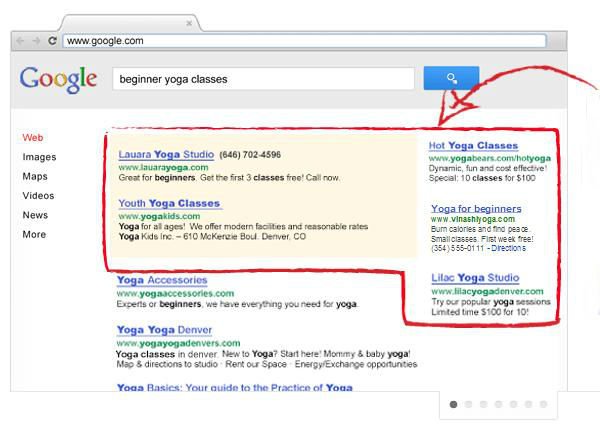Pay-per-click online advertising has many names:
- Pay-Per-Click
- Cost-Per-Click
- PPC Advertising
- AdWords
But they are all essentially the same thing. You pay Google (or Bing) directly to show up when a potential customer is searching for your services.
Pay-Per-Click is the most instant and directly measurable online advertising strategy. It’s really the only ‘guaranteed’ way to show up on the “first page in a Google search”, as the telemarketers say. It also gives you very valuable insight into what people are looking for, and how they are describing it.
It’s not cheap. Or rather, it’s not worth doing unless you’re prepared to invest in it.
Basically, you’re bidding for search terms. Let’s say, for instance, that you want your business to get found when someone types in “Yoga Classes” . You sign up with Google to run an Adwords campaign. You then “bid” a dollar amount for the phrase “Yoga Classes”. Let’s say you bid $2. This means that every time someone in your area types “yoga classes” into Google, your advertisement will show up. If that someone then actually clicks on your advertisement, and goes to your website, you pay Google $2 (whether the ‘clicker’ becomes an eventual customer or not).
Here’s the catch: the more you bid – the higher Google places your ad in relation to your competitors. And the more likely people will click on your ad. And the more you’ll pay Google. And (hopefully!) the more business you’ll generate.
So again, be prepared ‘to go big’, or don’t go at all! Google recommends that you be prepared to spend at least $800 a month – more is better – on an AdWords campaign.
Google allows you to set up a daily budget, and a daily “max” so that you can control your spending. Also, Google will “reward” you above and beyong your actual bid, and show your ad higher if it is relevant and well-written.
Pros of Pay-Per-Click
- Get Seen Immediately
SEO is a strategy that requires time. Reaching the first page of results for competitive keywords and phrases generally takes between six and twelve months, or even longer. If you plan on pursuing SEO but don’t want to wait a minimum of six months to start bringing new leads to your website, pay-per-click marketing is a great complement to SEO. With PPC, you can set up a campaign and start bringing in targeted traffic in less than 48 hours.
- Control the Visitor Experience
With Google’s normal search results, you never know exactly what page on your website may show up as the first result for specific searches. This can make it difficult to optimize the path you want new visitors to follow. One of the great things about AdWords is you can choose the exact page you want to link to specific queries.
Cons of Pay-Per-Click
- Visibility Doesn’t Mean Conversions
Many businesses get very excited when they set up their first AdWords campaign, only to become discouraged when they realize their ads aren’t generating any traffic. In order for a PPC campaign to drive results, every piece of the campaign has to work together. The campaign must target a set of keywords that people actually search for and that are a good match with your business. Then the ads have to be optimized to grab searchers’ attention and compel them to click.
- Every Single Visit Costs
Even when you do manage to get searchers to click, you may still be frustrated if only a few of those visitors convert into leads or customers—and since every click costs, it doesn’t take long for a steady stream of visitors who don’t convert to get very expensive. That reality is why PPC success requires a combination of keyword management, compelling ads and optimized landing pages that persuade visitors to submit their contact information or make a purchase.

